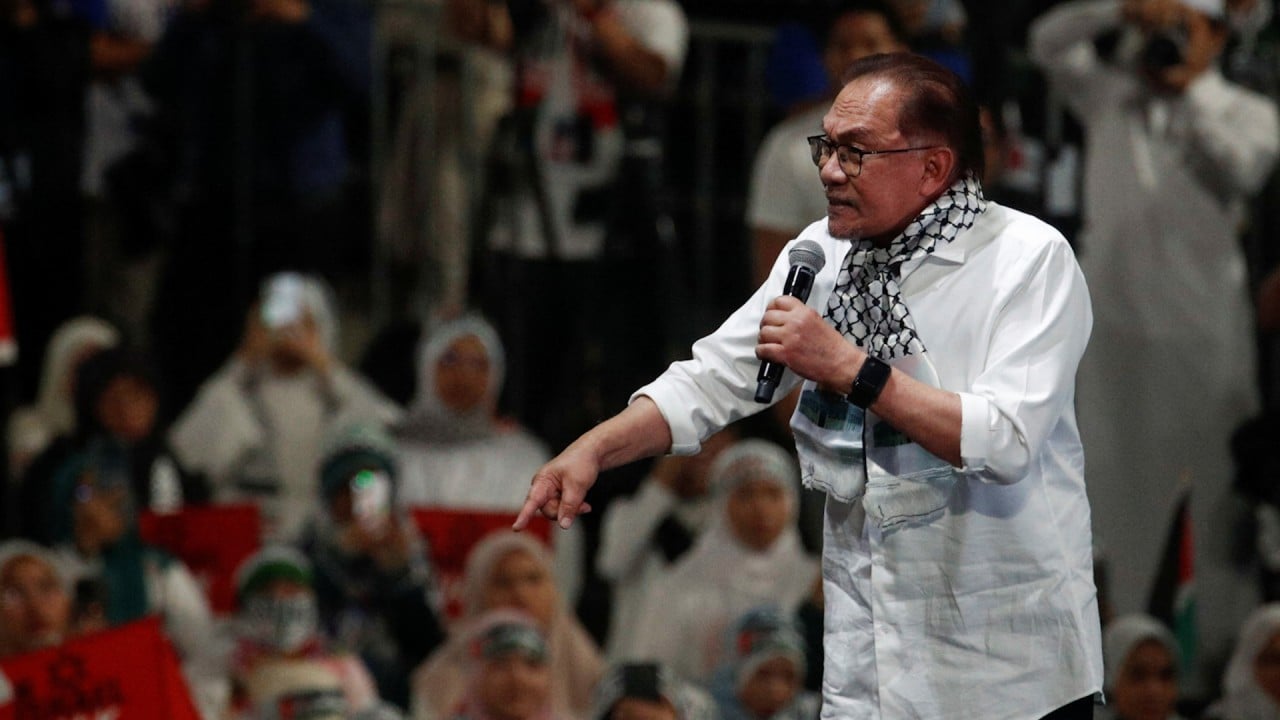Israel-Gaza war: China’s stance belies years of cooperation, including arms deals, with Israel

With China-US competition set to stay, and possibly even further intensify in the foreseeable future, experts say that more frictions between China and Israel are inevitable.
And the ongoing Israel-Gaza war brings extra complexity to Israel’s ties with Beijing. Israel’s foreign ministry expressed “deep disappointment” over China’s lack of condemnation of Hamas, and its envoy to the UN said he was “shocked to the core” while criticising the veto by China and Russia of the American proposal at the UN Security Council.
As early as January 1950, Israel became the first country in the Middle East to formally recognise the People’s Republic of China which was established just months before. It followed the Chinese Communist Party welcoming the launch of the State of Israel in 1948.
But any attempt at contact was interrupted by the Korean war a few months later, with Beijing joining North Korea to fight against US-led UN forces.
The door between China and Israel began opening – marked by rising trade and arms deals – in the 1980s during Beijing’s period of warming relations with Washington. Israel joined other US allies in selling advanced weapons to China, even before the establishment of official diplomatic ties in 1992.
One of the best-known cases in the 1980s was the technology transfer of Israel’s Python-3 air-to-air missiles. The People’s Liberation Army not only bought the munition to arm its fighter jets, but also obtained a licence to produce them at home. Eventually, based on Python technologies, the Chinese developed the PL-8 missile family, including ground-to-air and ship-to-air variants.

Israel was alleged to have shared with China some technology and design concepts of its cancelled prototype fighter the Lavi, benefiting the development of China’s fourth-generation fighter jet, the Chengdu J-10.
Although both sides denied any direct cooperation, the J-10 bears a notable resemblance to the Lavi, such as its delta wing, double canard configuration and air inlet design. While considered an indigenous Chinese design, it was widely believed that the J-10 drew inspiration and references from the expertise and technology transfer associated with the Lavi project.
China’s honeymoon with the West ended abruptly with the Tiananmen Square crackdown in 1989. The US and most of its European allies said they would suspend military technical cooperation projects with Beijing and subsequently banned arms sales to China.
Israel-Gaza war: China backs Global South, defying US-led support for Israel
Israel-Gaza war: China backs Global South, defying US-led support for Israel
But Israel – which like China remains outside the Wassenaar Arrangement on weapon export controls that was established in 1996 – made its defence cooperation with China low profile, and sometimes secret. According to data from the Stockholm International Peace Research Institute (SIPRI), arms exports from Israel to China stayed between US$28 million and US$38 million each year throughout the 1990s.
Examples from the period include the sales of Python-4 missiles and the initial transfer of Harpy anti-radiation drones. Some US and Russian military observers also said the Chinese vehicle-mounted HJ-9 anti-tank missiles may have been developed based on Israeli Mapats (Man-Portable Anti-Tank System) missiles, because the two missiles appeared almost identical, although no evidence has been established.
The link was finally broken after repeated US intervention. Israel agreed in 1996 to supply four sets of advanced Phalcon airborne early warning and control systems (AEWC) to China at a total of US$1 billion for mounting on Russian-made Ilyushin Il-76 transport aircraft. The fitting of the first plane was completed in early 2000 but the delivery was called off by the US government.
Despite Israel’s claim that the Phalcon did not contain American technology, Washington was concerned that by possessing the advanced AEWC with a 400km (248-mile) range and 360-degree coverage, China could undermine US military superiority in the Asia-Pacific region, especially to gain an advantage in a potential offensive operation on Taiwan.

Under mounting pressure from the US, Israel ultimately cancelled the Phalcon deal in July 2000. This decision strained Israel’s relations with China while also complicating its ties with the US. Israel agreed to pay China US$350 million in compensation, and also worked to rebuild its relations with the US.
In 2005, it was a similar story when China sent its Harpy drones back to Israel to be upgraded. Washington again objected to the deal even though the Harpy did not include any US-produced subsystems. The Israeli loitering munition is designed to attack enemy radar systems and the upgrade would have a datalink and sensors for better ground control. The deal was eventually cancelled and defence exchanges between Israel and China came to a halt.
“The United States has always been the biggest negative factor constraining the development of China’s relations with Israel,” said Liu Zhongmin, professor of Middle Eastern studies at Shanghai International Studies University.
“Israel’s inability to free itself from US control means it must sacrifice the relationship with China to preserve the US-Israel special relationship from time to time.”
Since the Harpy and Phalcon-related incidents, there has been little news about arms trade and military technology exchanges between Israel and China.
In 2011, Israel’s defence minister visited China and the PLA chief of staff visited Israel as the two countries restarted military exchanges. The PLA fleet was welcomed by its Israeli peers in Haifa, marking the first port call of the Chinese navy to the country.
But the exchanges focused on non-traditional security areas such as counterterrorism, anti-piracy, humanitarian relief and disaster prevention, according to Chinese military commentator Song Zhongping.
“Cooperation between China and Israel has now become extremely sensitive as China has become America’s main adversary and the target of containment and control,” he said.
Song said this not only affected Israel’s arms sales and tech transfer to China but also the reverse – Chinese military supplies to Israel – because Israel received large amounts of US military aid and the use of that money became restricted.
Israel has been the top recipient of US foreign aid since World War II, receiving more than US$260 billion from 1946 to 2023, according to USAID Data Service’s inflation-adjusted figure.
In particular, US aid money that was once intended for mostly economic support, became increasingly focused on military purposes from 1997, and especially so from the beginning of this century.
In 1999, the US government committed to providing US$2.67 billion in military aid each year to Israel for the next 10 years. In 2009, the annual amount was raised to US$3 billion; and for the third 10-year memorandum of understanding starting from 2019 the amount rose to US$3.8 billion a year.

At present, almost all US aid to Israel is in the form of military aid. In 2022, some 99.7 per cent of the US aid went to the Israeli military, and annual US grants represented around 16.5 per cent of the overall Israeli defence budget, according to a US Congressional research report.
In the Phalcon incident, the US threatened to withhold some of Israel’s annual aid if the deal with China went ahead.
But after the US repeatedly warned that China would use the port to spy on warships from the US Navy’s 6th Fleet that might dock nearby, the original Haifa port was sold to an India-led consortium in 2022 after an I2U2 Group summit – comprising the US, India, Israel and the United Arab Emirates (UAE) – and was hailed a success in US-backed efforts to counter China’s moves.
Additionally, the Israeli government blocked a joint bid by the China Railway Construction Corporation and an Israeli company for two Tel Aviv light rail lines after both the Trump and Biden administrations pressured them to keep the Chinese out.
Israel starts next stage of ‘long war’ as Gaza deaths top 8,000
Israel starts next stage of ‘long war’ as Gaza deaths top 8,000
Israel’s radical stance on Palestine – which has been strongly backed by the US – has always been a core difference between it and Beijing. China has traditionally supported Palestinian independence and advocates for the two-state solution, which is often interpreted by Israel as favouring Palestine.
Further, China’s growing “comprehensive strategic partnership” with Iran also concerns the Israelis.
At the beginning of the US-China trade war, trade, investment and cooperation between China and Israel saw significant growth as Beijing highly valued Israel’s innovation and technologies.
As the trade war escalated, Washington increased pressure on Israel to limit or ban cooperation with China in research and technology to address the possible loopholes.
“The US constantly stresses that much of Israel’s technologies, either military or civilian, contains [American technology], and all such hi-tech exchanges must not be allowed,” Song said.






